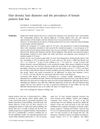Shared Phenotypes Among Segmental Progeroid Syndromes Suggest Underlying Pathways of Aging
January 2005
in “
The Journals of Gerontology Series A
”
TLDR Short telomeres may cause symptoms like hair loss and osteoporosis, offering insights into aging.
The document analyzed segmental progeroid syndromes, which mimic accelerated aging, and proposed that short telomeres might cause similar symptoms across different syndromes. Key findings included that short telomeres were linked to a group of symptoms such as alopecia, osteoporosis, and fingernail atrophy. Fingernail atrophy in these syndromes was similar to the natural slowing of nail growth seen in normal aging, suggesting it could be a marker of replicative aging in keratinocyte stem cells. Alopecia and reduced hair diameter were found to parallel the nail growth results. Osteoporosis in Dyskeratosis Congenita was similar to age-related osteoporosis, unlike in other progerias. Additionally, gray hair was associated with short telomeres and possibly reactive oxygen species. These findings led to predictions about aging pathways, suggesting that studying these syndromes could provide insights into normal aging processes.

